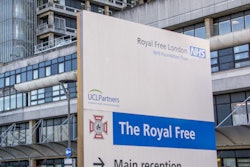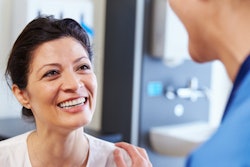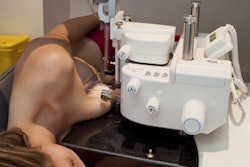
In today's healthcare landscape, physicians and institutions are held accountable for delivering top-quality care that not only meets budget and efficiency requirements, but also improves patient satisfaction scores. In an era when these scores directly impact performance reviews and reputations for doctors and facilities, it makes sense for healthcare administrators tasked with evaluating their institution's bottom lines to be especially conscientious of investing in options that will improve the patient experience.
To do so, healthcare providers don't necessarily have to compromise on workflow and cost efficiency; rather, the solutions they seek could and should be mutually beneficial. For example, reducing wait time and procedure time for breast biopsies is better for patients and it also allows radiologists to perform more procedures, or read more mammograms in a day, which directly affects the bottom line.
 Dr. Jennifer Adams
Dr. Jennifer AdamsAs a board-certified diagnostic radiology specialist, I keep these factors in mind each day while performing breast screenings and diagnostic procedures. My patients rely on me not only as a trusted healthcare provider, but also as a support system. As a breast cancer survivor myself, I'm acutely aware of what my patients are going through -- from the time they walk into the waiting room until the moment they leave.
The screening and biopsy experience
I felt a lump in my breast at age 38 -- just two years after I had a baseline mammogram, which was normal. I subsequently went for a mammogram that revealed a concerning solid mass, and as a result, I had a breast biopsy.
I felt extremely anxious before I even arrived at the facility for the biopsy. When I got there, my apprehension only continued to build in the waiting room, a common reaction that many of my patients experience in anticipation of being called back for their procedure.
In many cases, women who are in the office to get an annual mammogram are sharing the same waiting room with those who are scheduled for a breast biopsy procedure. While the woman awaiting her mammogram may be feeling impatient, wanting to check the screening appointment off her list so she can move on with her day, the woman anticipating her biopsy is likely very tense as she braces herself for a procedure that could result in devastating news. This arrangement can foster an inconsistent and uncomfortable environment among all patients, who are simultaneously experiencing an array of emotions.
Once a biopsy patient is called back to a procedure room, her apprehension will continue to grow, especially if she is particularly uneasy in close proximity to needles. In addition to causing emotional distress, a breast biopsy often results in physical discomfort and in some cases pain -- both during and after the procedure. The needle is not the only part of the procedure that causes discomfort: Many prone biopsy tables can actually be very uncomfortable on their own. And sometimes patients are biopsied in an upright position with the needle in direct view, which can be even more unpleasant.
What's more, patients have to be positioned on the table, or in the upright position, in a way that ensures the radiologist will be able to reach the targeted area of concern in the breast, which is sometimes located in a hard-to-reach region. This causes additional physical discomfort for patients who have to hold their bodies in an unconventional position for an extended period of time to provide the best angle for suspicious tissue to be extracted.
Furthermore, there are other factors besides the location of the questionable tissue that can create even more discomfort during the procedure, such as a woman's body habitus, particularly during a prone stereotactic biopsy. For example, if a patient has a spine issue, or even a large abdomen, she will likely experience more pain and trouble maintaining a position that gives radiologists the angle needed, given the pre-existing complications already associated with her physique.
Once finally in position, the patient must remain completely still as the radiologist probes with the needle to acquire a tissue sample and then verifies that it contains a portion of the abnormality identified on the mammogram. If the section removed is unsatisfactory, the process -- from specimen extraction to verification -- continues until the verification proves positive.
In many cases, the technology required to verify the samples is not in the same room as the patient's procedure, so the radiologist must leave the patient, with the needle still in her breast, to verify the sample in another room. This time lapse can leave patients in a prolonged state of emotional and physical discomfort.
After an emotionally and physically draining process, the patient is still not quite done. She must nervously await her diagnosis. After my biopsy, I learned that I had stage IIIB breast cancer and would need to begin treatment. Despite already enduring the less-than-pleasant breast biopsy experience, those who receive a cancer diagnosis still have a grueling fight ahead of them.
Lessons learned
Based on my own experience and the many breast biopsy procedures I have performed for countless women over the years, I've gained a deeper insight into the components of the breast screening and biopsy processes. And, while no patient circumstances are exactly alike, I have learned there are similarities across the board that demonstrate room for improvement throughout the experience.
First, women are anxious: From the moment they enter the waiting room until procedure completion, they are naturally going to feel uneasy. While a breast biopsy will certainly never be an enjoyable experience, administrators should keep in mind a woman's angst and how they can ease it when they are considering the design of a facility.
For example, it might make more sense to have separate waiting rooms for women who are getting regular mammograms and those who are scheduled for breast biopsy procedures. Likewise, to make biopsy patients feel more relaxed, perhaps their waiting room should have more of a spa-like environment, with soothing ambiance and calming music.
Furthermore, simply put, breast biopsies can be painful and uncomfortable. While one could argue that no medical procedure is inherently comfortable, R&D specialists should consider this aspect of the patient experience when developing new products.
For example, there may be room for biopsy tables to be more flexible and adaptable to different body types with features that help hold a patient in place without making her work too hard to do this on her own. Likewise, it would make more sense if the compression plates were transparent so that technologists and radiologists could more easily identify the area of tissue needed by using other landmarks on the body. This could help increase the likelihood that the first extracted sample proves positive for verification, which would reduce the overall time of the procedure and duration of pain for the patient.
The breast biopsy procedure as a whole takes a very long time. Tissue sample verification, for example, particularly delays the process, especially for technologists and radiologists operating in facilities that lack technology allowing tissue verification in the procedure room. The amount of time spent traveling outside the procedure room to complete the task can average around five to 10 minutes per biopsy, which extends the length of time patients are on a biopsy table experiencing physical pain and building up more anxiety.
This, in turn, can increase the amount of time for other patients who still need to be seen for their appointments, creating even more tension in the waiting room. Facility managers and R&D specialists should be pursuing solutions to shorten breast biopsy time, as the lengthy nature of the procedure is undoubtedly in need of remedy.
Come together
Overall, it's evident that there is a clear need for radiologists, hospital administrators, and R&D specialists to come together in search of answers to the worrisome shortcomings that exist throughout the breast screening and diagnostic process. I know firsthand that experiencing a breast biopsy, and in some cases a subsequent cancer diagnosis, is never an ideal situation. However, any strides that can be made to ease the process for anxious patients are certainly worthwhile.
Improving the patient experience is not only better for the patients themselves, but it is also beneficial for radiologists and administrators. My experiences have given me the insight to serve as a better radiologist and support system to my patients. I believe that working together to provide patients with superior care is an effort that will yield positive results for all, from happier and healthier patients to better-performing doctors and facilities.
Dr. Jennifer Adams graduated from the Medical University of South Carolina College of Medicine in 1999. She works in Anderson, SC, and specializes in diagnostic radiology.



















